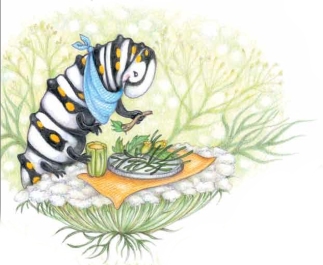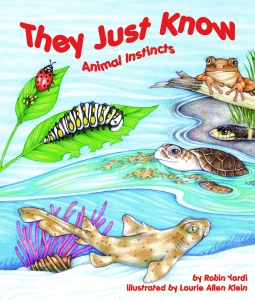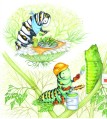Today I’m interviewing Laurie Allen Klein, illustrator of THEY JUST KNOW, ANIMAL INSTINCTS. Her new book explores how some young animals just know what to do without any help. The book has all sorts of fun indulging the way kids THINK animals grow up… before setting them beautifully straight. And like all Arbordale books, the For Creative Minds section at the end of the book contains printable activities on animal instincts, learned behaviors, life cycles, and metamorphosis!
You can enter to win a copy of your own on Goodreads by clicking the book’s cover below!
Hi Laurie, it’s so exciting to interview you for the Nonfiction Nook! Usually when interviewing illustrators, I try to be a little more professional and removed, but since YOUR book is OUR book I feel like doing a little dance.
Hooray & welcome!!!!!!!!
The very first work of yours for the book I got to see was the fully sketched dummy as a pdf, and I was so pleased and excited. The way you go back and forth between humorous anthropomorphic and beautiful realistic spreads was EXACTLY what I had envisioned. Now, we never chatted while the book was being created, I never said (even to our editor), I want one spread to look like this and another to look like that, which is a fact nervous authors out there might appreciate. So, I wonder, how and when did you decide to give the book that visual rhythm?
 Interestingly enough, when I first read the manuscript I had a whole different idea in mind, but to be fair, it was a real quick read. I was in the midst of finishing another book when I got the e-mail from Arbordale asking if I would be interested in illustrating your story, so I read it through to get the gist of the narrative and subject matter. The Basic theme was right up my alley in terms of subject matter so I quickly said yes, and then turned my attention back to the illustrations for the other book.
Interestingly enough, when I first read the manuscript I had a whole different idea in mind, but to be fair, it was a real quick read. I was in the midst of finishing another book when I got the e-mail from Arbordale asking if I would be interested in illustrating your story, so I read it through to get the gist of the narrative and subject matter. The Basic theme was right up my alley in terms of subject matter so I quickly said yes, and then turned my attention back to the illustrations for the other book.
I knew, from that first quick read, that the book was naturalistic, depicting the different stages of development, and because most of the animals were relatively small (certainly their earliest phases were) I pictured the spreads being extreme close-up, with lots of realistic detail of each stage, while the background would be kind of blurry and out of focus. So that was the basic idea I had in mind, and the direction I intended to take.
Fast forward to several weeks later. I was giving a Book Talk to a 4th grade class. On this particular day I was showing the class the illustrations for the book I had just finished, but I happened to take your manuscript with me because I thought the kids might find it interesting to hear the story, without any art yet, and follow me through the entire illustration process from Start to Finish, Words to Pictures.
After we finished talking about the finished color illustrations for the previous book I read They Just Know to the class, suggesting they listen to the words and see what kinds of images came to their minds. Now I need to stress – I hadn’t read the manuscript since that first day I got the e-mail, and beyond imagining a series of extreme natural/realistic close-ups I hadn’t had the opportunity to think about the book, so this was only the second time I’d actually read the words with any real concentration. Plus, I was reading to a class of 4th graders.
 I’m sure I would have realized the anthropomorphic elements on my own when I sat down to seriously start work on the book, but I think reading the story aloud, to a class of elementary school students, really brought the anthropomorphic quality home. I suddenly noticed the funny comparisons between human children and their animal counterparts and I was stunned! It really took me by surprise, but even while I was reading, the creative gears were turning and a whole new visual direction began to materialize.
I’m sure I would have realized the anthropomorphic elements on my own when I sat down to seriously start work on the book, but I think reading the story aloud, to a class of elementary school students, really brought the anthropomorphic quality home. I suddenly noticed the funny comparisons between human children and their animal counterparts and I was stunned! It really took me by surprise, but even while I was reading, the creative gears were turning and a whole new visual direction began to materialize.
It was truly a “Eureka!” moment.
I read the story more closely then, and saw the distinct separation between anthropomorphic wording and the natural descriptions so I decided I would keep my realistic close-up approach for the nature-based passages but take a more humorous approach with the anthropomorphic sections. I grew up with Disney movies and my favorite children’s books have always been the ones where animals act like people, so this book gave me the chance to share all my childhood influences.
In some of the illustrations (especially on the funny spreads) there are sneakily hidden animal facts, things you would only know to include if you did a BUNCH of your own research. Do you do this to make the work fun for yourself, to make the book fun for kids… or both?
First and foremost, and the thing I like to stress at every Book Talk and School Presentation is – I absolutely love, love, LOVE doing research! I enjoy looking up facts and reference pictures, the more information I discover the more I can put into an illustration. And looking up information on one subject inevitably leads you to new, unexpected connections which—again—serve to make an illustration more visually rich and interesting. For me it helps take the story, and the illustrations, to a different level. The reader may not notice anything the first time, but my hope is that every time the story is read again new things will be discovered.
 And I like to be as factual as possible. For example, in TJK, the first page describes a butterfly but doesn’t indicate what type of butterfly it is. I could have just made up a generic sort of cartoony butterfly, but since I had to draw one anyway why not make it a real one. I purposely chose an Eastern Black Swallowtail because I liked the way the caterpillar and chrysalis looked. Also, all the plants and flowers shown in the pictures are the kinds of Host Plants and Nectar Plants Eastern Black Swallowtails use.
And I like to be as factual as possible. For example, in TJK, the first page describes a butterfly but doesn’t indicate what type of butterfly it is. I could have just made up a generic sort of cartoony butterfly, but since I had to draw one anyway why not make it a real one. I purposely chose an Eastern Black Swallowtail because I liked the way the caterpillar and chrysalis looked. Also, all the plants and flowers shown in the pictures are the kinds of Host Plants and Nectar Plants Eastern Black Swallowtails use.
So, what are some of the favorite things you learned and included in the illustrations?
Oh there are lots of things. I had particular fun with the new butterfly learning to fly because my husband is a pilot, and our daughter took flying lessons, so all those books and charts are based on the things they both used in their training.
 On the Horn Shark page I purposely showed the type of food Horn Sharks eat. And I think one of my favorite images is the Angler Fish serving as a nightlight.
On the Horn Shark page I purposely showed the type of food Horn Sharks eat. And I think one of my favorite images is the Angler Fish serving as a nightlight.
 For the Ladybug pages – I had no idea a Ladybug goes through so many stages! Illustrator trick short cut – I colored all the stages on the naturalistic page first, then made color copies of the ones I needed, cut them out, and glued them directly onto the leaf-bulletin board art on the anthropomorphic page so each stage would look exactly the same on both spreads.
For the Ladybug pages – I had no idea a Ladybug goes through so many stages! Illustrator trick short cut – I colored all the stages on the naturalistic page first, then made color copies of the ones I needed, cut them out, and glued them directly onto the leaf-bulletin board art on the anthropomorphic page so each stage would look exactly the same on both spreads.
 On the Spring Peeper page – that is a real mathematical formula for frog jumping seen on the garden slate blackboard. Well, technically it’s a couple different formulas, I just put them all on the slate. This is my favorite detail in the whole book 🙂
On the Spring Peeper page – that is a real mathematical formula for frog jumping seen on the garden slate blackboard. Well, technically it’s a couple different formulas, I just put them all on the slate. This is my favorite detail in the whole book 🙂

Also I’m particularly fond of the look on the Mom Snake’s face (with her angry tapping “foot”) and the expressions on the two kid snakes. SIDE NOTE: Did you notice they were playing Snakes and Ladders. Ha! Yes, indeed I did!
 Laurie, do you have any questions for me? What do illustrators always wish they could ask authors?
Laurie, do you have any questions for me? What do illustrators always wish they could ask authors?
I guess my biggest question is – How difficult is it to see your words visually interpreted by a stranger? Is it weird to see characters look different than you imagined when you were writing the story?
When I first started writing this was difficult for me (in all my imaginary books). I used to put ALL sorts of illustrator notes in my manuscripts. I can’t tell you when I stopped feeling this way… it just happened. I did imagine the visual rhythm in THEY JUST KNOW, but I decided that if I controlled the verbal rhythm in the manuscript well enough, that my vision might become yours. And it did!
I guess the follow up would be – Have you ever been completely surprised by the direction an illustrator took? Pleasantly or otherwise?
Yes! I just got to see the cover for my upcoming middle grade novel and I was VERY surprised. The book is about three kids that get into a midnight war with some stinky trike-riding skunks and an army of vicious raccoons (who did you think played on your neighborhood playground all night?). Anyway, the cover doesn’t [TOP SECRET – INFORMATION REDACTED] and the snarly raccoons on the cover? They’re [TOP SECRET – INFORMATION REDACTED]. Those were surprises, but to me they were wonderful ones. It was like the artist peeked into me, not just into the book, to create that cover! We are doing a reveal soon on the Teen Librarian Toolbox blog… I’ll keep you posted!
How do you decide what you want to write about, and the point of view you’re going to take? I ask because my dream is to one day write (and illustrate) a story of my own, but when it comes to the actual writing part I get overwhelmed by all the narrative possibilities. First person, third person, memoir, chapters, picture book, first reader, young adult.
Oooh! What kind of book do you dream of?? Tell me later!
I don’t always consciously decide how I’m going to tell my story. The first thing that comes is a FEELING. I hear a kid say something, or I say something to a kid, and suddenly I can feel this quiet space between words and the story starts to become something real in my mind. THEY JUST KNOW started when my grandmother and daughter were pretending to be a mother and baby butterfly. I said, “Did you know, butterflies never meet their mothers?” My daughter’s eyes went wide, my grandmother made a different sort of face, maybe because I’d spoiled their fun game, and then there was quiet. My daughter waited expectantly for me to explain my audacious claim. That waiting, that wanting to know, is where I think my stories start. I do often explore different points of view and formats, but usually in a revision. When I’m writing I don’t worry about that stuff.
Not to mention, my bigger/biggest problem is – all the subjects that fascinate me. I have notebooks full of plot ideas and character descriptions, even snippets of dialogue, but then can never narrow down my topic. What calls to you first? The subject? The story? The style?
Ha! I do this too. I once wanted to write an entire book of poems about spiders (I love those little creeps so much), but I became overwhelmed with the possibilities. SO MANY AMAZING SPIDERS. I mean, just look at this little guy:
I knew I had to reign myself in, so I decided to write only about spiders that lived in the Sonoran Desert, but then I thought, WHAT ABOUT ALL THE OTHER SONORAN ANIMALS, HUH??? So I had to put them in too and what began as a book about spiders has become a web of interacting poems about snakes and storms and pronghorn and javelina and a few spiders too.
And of course – Do you have a dream project you haven’t tackled yet?
Whatever I’m working on RIGHT NOW is my dream project! I have dreamt of rainbows and rosy boas and spiders, of skunks and raccoons and even little kids. Maybe sometime all of those dreams will become books. 😉
Thanks so much for answering my questions and for asking such amazing ones. I can’t wait until our book gets out there!
❤ Robin








I’ve always loved that a chameleon just knows how to change it’s colors! Instinctual behaviors almost seem like magic!
Ever since I was a child I have always loved and been fascinated by animals and their behavior. We grew up “saving” turtles who we’re trying to cross the road, collecting frogs, and bugs, etc. One of the most fascinating animals to me was always the platypus. I only learned recently that the male platypus actually has a venomous spur on it’s heel!
I look forward to this time of the year when the Monarch butterflies instinctively know to fly south to Mexico. It’s wonderful to share their life cycle with students and see how delighted the kids are when the butterflies flutter across the playground. 🙂